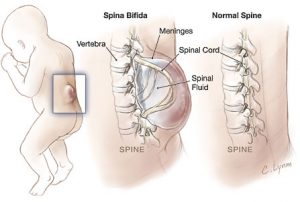What is Spina Bifida?


Spina Bifida Quick Facts
Causes of Spina Bifida
Doctors and scientists believe that a complex mix of both genetic and environmental factors act together to cause Spina Bifida. Every woman of childbearing age is at risk of having a pregnancy affected by a birth defect. These factors present themselves very early in the pregnancy, as early as the fourth week. Although the exact causes of Spina Bifida are unknown, research has found folic acid can aid in preventing neural tube defects like Spina Bifida.
Diagnosing Spina Bifida
Spina Bifida can be detected in utero by one of the following tests:
Blood test: An expectant mother can take a blood test called the alpha-fetoprotein (AFP screening test) which is administered during the 16th to 18th week of pregnancy.
Ultrasound: When an expectant mother receives an ultrasound, also called a sonogram, the doctor will be able to see images of the fetus and possible signs of Spina Bifida, like an open spine.
Maternal Amniocentesis: This is a test where a small amount of fluid can be taken from the expectant mother’s womb through a thin needle. It can be used to look at protein levels which can indicate a diagnosis of Spina Bifida.
It is important to remember that no medical test is perfect and some results are not always accurate.
Types of Spina Bifida
Although no two cases of Spina Bifida are identical, there are three main types of Spina Bifida which are the most common.
Spina Bifida – Myelomeningocele: This form of Spina Bifida can be seen as a sac of fluid on the baby’s spine. It can be either open or closed, with the spinal cord and/or nerves exposed or concealed by the sac. Because of this, part of the spinal cord and nerves are typically damaged. This damage may affect how a person uses their extremities, goes to the bathroom, and functions overall.
Spina Bifida – Meningocele: This form of Spina Bifida can also be seen as a sac of fluid on the baby’s spine. The difference between this and Myelomeningocele is that the spinal cord and/or nerves do not protrude into the sac. However, this type of Spina Bifida may still cause changes in the person’s abilities.
Spina Bifida – Occulta: This form of Spina Bifida is considered the most mild form, as it typically presents no symptoms and is rarely identified at birth, if at all. When the condition is found, it is typically later in life and through incidental finding when taking other tests. This type of Spina Bifida leaves a small gap in the spine. But, it is possible to have this type and not have it affect any of the person’s abilities. More on Occulta here.
Treating Spina Bifida
Because there are different types of Spina Bifida and levels of severity, treatment should be individualized. The following are initial treatments that may be done based on the type of Spina Bifida the baby is born with. Often, people with Spina Bifida will receive various surgeries, therapies, and have multiple medical appointments across their lifespan to manage their health.
A child with myelomeningocele usually is operated on within two to three days of birth. This prevents infections and additional damage to the spinal cord.
A child with meningocele usually is treated with surgery, and more often than not, the child is not paralyzed. Most children with this condition grow up without complications, but they should be checked by a doctor because they could have other serious problems, too.
A child with OSD should see a surgeon. Most experts think that surgery is needed early to keep nerves and the brain from becoming more damaged as the child grows.
Spina Bifida occulta typically does not require treatment.
Prevention
While there is no known cause, it has been shown that women who are old enough to have babies should take folic acid before and during the first three months of pregnancy. Because half of the pregnancies in the United States are unplanned, the Spina Bifida Association asks women to take a vitamin with 400 mcg (0.4 mg) of folic acid each day during the years of their lives when they are possibly able to have children.
Spina Bifida is usually not caused by something the parents did or did not do.
Additionally, women who have a child or sibling with Spina Bifida, have had an affected pregnancy, or have Spina Bifida themselves should take 4000 mcg (4.0 mg) of folic acid for one to three months before and during the first three months of pregnancy. It’s important to know that neural tube defects like Spina Bifida are not entirely understood, and Spina Bifida is usually not caused by something the parents did or did not do. It is recommended that adults with Spina Bifida and couples who already have a child with Spina Bifida talk with their OB-GYN or genetic counselor about their risk factors and ways to reduce the risk.
